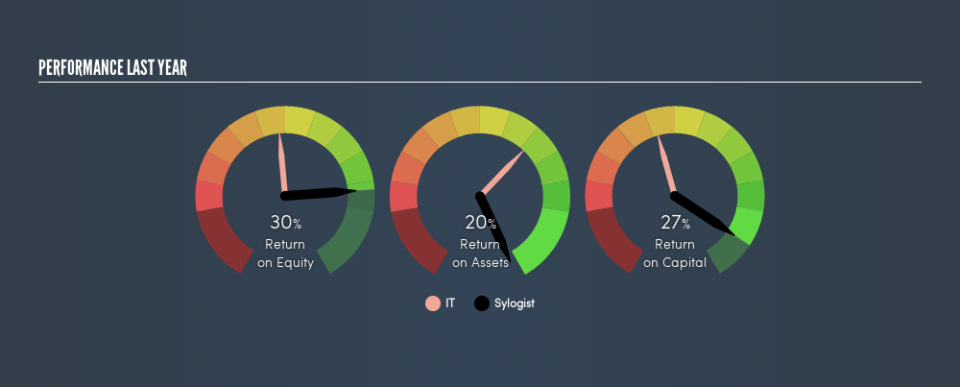Sylogist Ltd. (CVE:SYZ) Earns A Nice Return On Capital Employed

Today we'll evaluate Sylogist Ltd. (CVE:SYZ) to determine whether it could have potential as an investment idea. Specifically, we'll consider its Return On Capital Employed (ROCE), since that will give us an insight into how efficiently the business can generate profits from the capital it requires.
First up, we'll look at what ROCE is and how we calculate it. Second, we'll look at its ROCE compared to similar companies. Finally, we'll look at how its current liabilities affect its ROCE.
Return On Capital Employed (ROCE): What is it?
ROCE is a metric for evaluating how much pre-tax income (in percentage terms) a company earns on the capital invested in its business. All else being equal, a better business will have a higher ROCE. In brief, it is a useful tool, but it is not without drawbacks. Renowned investment researcher Michael Mauboussin has suggested that a high ROCE can indicate that 'one dollar invested in the company generates value of more than one dollar'.
How Do You Calculate Return On Capital Employed?
Analysts use this formula to calculate return on capital employed:
Return on Capital Employed = Earnings Before Interest and Tax (EBIT) ÷ (Total Assets - Current Liabilities)
Or for Sylogist:
0.27 = CA$12m ÷ (CA$62m - CA$16m) (Based on the trailing twelve months to March 2019.)
Therefore, Sylogist has an ROCE of 27%.
Check out our latest analysis for Sylogist
Is Sylogist's ROCE Good?
When making comparisons between similar businesses, investors may find ROCE useful. Using our data, we find that Sylogist's ROCE is meaningfully better than the 10% average in the IT industry. We consider this a positive sign, because it suggests it uses capital more efficiently than similar companies. Setting aside the comparison to its industry for a moment, Sylogist's ROCE in absolute terms currently looks quite high.
Our data shows that Sylogist currently has an ROCE of 27%, compared to its ROCE of 10% 3 years ago. This makes us think the business might be improving. The image below shows how Sylogist's ROCE compares to its industry, and you can click it to see more detail on its past growth.
It is important to remember that ROCE shows past performance, and is not necessarily predictive. ROCE can be misleading for companies in cyclical industries, with returns looking impressive during the boom times, but very weak during the busts. ROCE is only a point-in-time measure. Since the future is so important for investors, you should check out our free report on analyst forecasts for Sylogist.
Do Sylogist's Current Liabilities Skew Its ROCE?
Short term (or current) liabilities, are things like supplier invoices, overdrafts, or tax bills that need to be paid within 12 months. Due to the way ROCE is calculated, a high level of current liabilities makes a company look as though it has less capital employed, and thus can (sometimes unfairly) boost the ROCE. To check the impact of this, we calculate if a company has high current liabilities relative to its total assets.
Sylogist has total assets of CA$62m and current liabilities of CA$16m. As a result, its current liabilities are equal to approximately 27% of its total assets. A minimal amount of current liabilities limits the impact on ROCE.
What We Can Learn From Sylogist's ROCE
With low current liabilities and a high ROCE, Sylogist could be worthy of further investigation. Sylogist looks strong on this analysis, but there are plenty of other companies that could be a good opportunity . Here is a free list of companies growing earnings rapidly.
I will like Sylogist better if I see some big insider buys. While we wait, check out this free list of growing companies with considerable, recent, insider buying.
We aim to bring you long-term focused research analysis driven by fundamental data. Note that our analysis may not factor in the latest price-sensitive company announcements or qualitative material.
If you spot an error that warrants correction, please contact the editor at editorial-team@simplywallst.com. This article by Simply Wall St is general in nature. It does not constitute a recommendation to buy or sell any stock, and does not take account of your objectives, or your financial situation. Simply Wall St has no position in the stocks mentioned. Thank you for reading.

 Yahoo Finance
Yahoo Finance 
